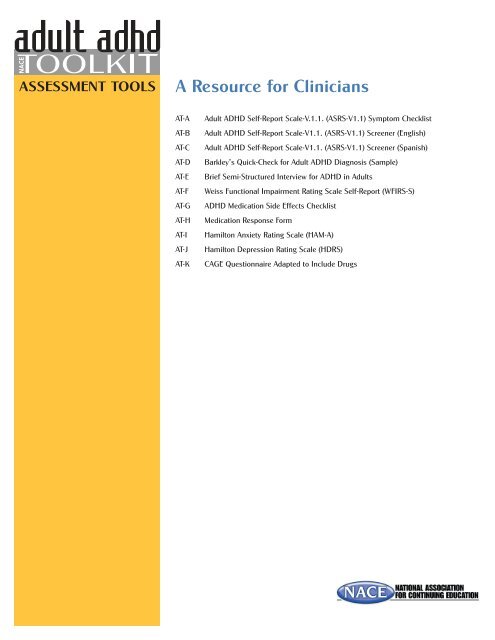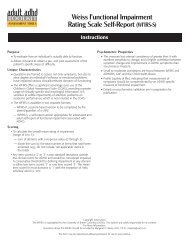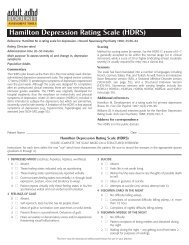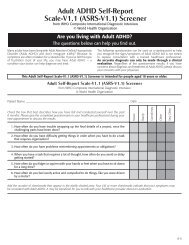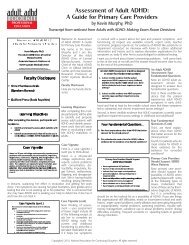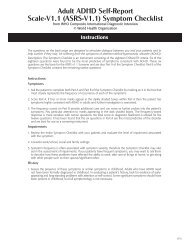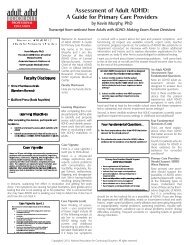A Resource for Clinicians - National Association for Continuing ...
A Resource for Clinicians - National Association for Continuing ...
A Resource for Clinicians - National Association for Continuing ...
Create successful ePaper yourself
Turn your PDF publications into a flip-book with our unique Google optimized e-Paper software.
ASSESSMENT TOOLSA <strong>Resource</strong> <strong>for</strong> <strong>Clinicians</strong>AT-AAT-BAT-CAT-DAT-EAT-FAT-GAT-HAT-IAT-JAT-KAdult ADHD Self-Report Scale-V.1.1. (ASRS-V1.1) Symptom ChecklistAdult ADHD Self-Report Scale-V1.1. (ASRS-V1.1) Screener (English)Adult ADHD Self-Report Scale-V1.1. (ASRS-V1.1) Screener (Spanish)Barkley’s Quick-Check <strong>for</strong> Adult ADHD Diagnosis (Sample)Brief Semi-Structured Interview <strong>for</strong> ADHD in AdultsWeiss Functional Impairment Rating Scale Self-Report (WFIRS-S)ADHD Medication Side Effects ChecklistMedication Response FormHamilton Anxiety Rating Scale (HAM-A)Hamilton Depression Rating Scale (HDRS)CAGE Questionnaire Adapted to Include Drugs
ASSESSMENT TOOLSAdult ADHD Self-ReportScale-V1.1 (ASRS-V1.1) Symptom Checklistfrom WHO Composite International Diagnostic Interview© World Health OrganizationInstructionsThe questions on the back page are designed to stimulate dialogue between you and your patients and tohelp confirm if they may be suffering from the symptoms of attention-deficit/hyperactivity disorder (ADHD).Description: The Symptom Checklist is an instrument consisting of the eighteen DSM-IV-TR criteria. Six of theeighteen questions were found to be the most predictive of symptoms consistent with ADHD. These sixquestions are the basis <strong>for</strong> the ASRS v1.1 Screener and are also Part A of the Symptom Checklist. Part B of theSymptom Checklist contains the remaining twelve questions.Instructions:Symptoms1. Ask the patient to complete both Part A and Part B of the Symptom Checklist by marking an X in the box thatmost closely represents the frequency of occurrence of each of the symptoms.2. Score Part A. If four or more marks appear in the darkly shaded boxes within Part A then the patient hassymptoms highly consistent with ADHD in adults and further investigation is warranted.3. The frequency scores on Part B provide additional cues and can serve as further probes into the patient’ssymptoms. Pay particular attention to marks appearing in the dark shaded boxes. The frequency-basedresponse is more sensitive with certain questions. No total score or diagnostic likelihood is utilized <strong>for</strong> thetwelve questions. It has been found that the six questions in Part A are the most predictive of the disorderand are best <strong>for</strong> use as a screening instrument.Impairments1. Review the entire Symptom Checklist with your patients and evaluate the level of impairment associatedwith the symptom.2. Consider work/school, social and family settings.3. Symptom frequency is often associated with symptom severity, there<strong>for</strong>e the Symptom Checklist may alsoaid in the assessment of impairments. If your patients have frequent symptoms, you may want to ask themto describe how these problems have affected the ability to work, take care of things at home, or get alongwith other people such as their spouse/significant other.History1. Assess the presence of these symptoms or similar symptoms in childhood. Adults who have ADHD neednot have been <strong>for</strong>mally diagnosed in childhood. In evaluating a patient’s history, look <strong>for</strong> evidence of earlyappearingand long-standing problems with attention or self-control. Some significant symptoms should havebeen present in childhood, but full symptomology is not necessary.This <strong>for</strong>m may be reproduced <strong>for</strong> use in your practice.AT-A
Adult ADHD Self-Report Scale (ASRS-v1.1) Symptom ChecklistPatient NameToday’s DatePlease answer the questions below, rating yourself on each of the criteria shown using the scaleon the right side of the page. As you answer each question, place an X in the box that bestdescribes how you have felt and conducted yourself over the past 6 months. Please give thiscompleted checklist to your healthcare professional to discuss during today’s appointment.iNeverRarelySometimesOftenVery Often1. How often do you have trouble wrapping up the final details of a project, once thechallenging parts have been done?2. How often do you have difficulty getting things in order when you have to do a taskthat requires organization?3. How often do you have problems remembering appointments or obligations?4. When you have a task that requires a lot of thought, how often do you avoid or delaygetting started?5. How often do you fidget or squirm with your hands or feet when you have to sit down<strong>for</strong> a long time?6. How often do you feel overly active and compelled to do things, like you were drivenby a motor?Part A7. How often do you make careless mistakes when you have to work on a boring ordifficult project?8. How often do you have difficulty keeping your attention when you are doing boringor repetitive work?9. How often do you have difficulty concentrating on what people say to you, even whenthey are speaking to you directly?10. How often do you misplace or have difficulty finding things at home or at work?11. How often are you distracted by activity or noise around you?12. How often do you leave your seat in meetings or other situations in which you areexpected to remain seated?13. How often do you feel restless or fidgety?14. How often do you have difficulty unwinding and relaxing when you have timeto yourself?15. How often do you find yourself talking too much when you are in social situations?16. When you’re in a conversation, how often do you find yourself finishing the sentencesof the people you are talking to, be<strong>for</strong>e they can finish them themselves?17. How often do you have difficulty waiting your turn in situations when turn takingis required?18. How often do you interrupt others when they are busy?Part B
The Value of Screening <strong>for</strong> Adults with ADHDResearch suggests that the symptoms of ADHD can persist intoadulthood, having a significant impact on the relationships, careers,and even the personal safety of patients who may suffer from it. 1-4Because this disorder is often misunderstood, many people who haveit do not receive appropriate treatment and, as a result, may neverreach their full potential. Part of the problem is that it can be difficultto diagnose, particularly in adults.The Adult ADHD Self-Report Scale (ASRS v1.1) and scoring systemwere developed in conjunction with the World Health Organization(WHO) and the Workgroup on Adult ADHD, which included thefollowing team of psychiatrists and researchers:Lenard Adler, MDAssociate Professor of Psychiatry and NeurologyNew York University Medical SchoolRonald Kessler, PhDProfessor, Department of Health Care PolicyHarvard Medical SchoolThomas Spencer, MDAssociate Professor of PsychiatryHarvard Medical SchoolAs a healthcare professional, you can use the ASRS v1.1 as a tool tohelp screen <strong>for</strong> adult ADHD patients. Insights gained through thisscreening may suggest the need <strong>for</strong> a more in-depth clinician interview.The questions in the ASRS v1.1 are consistent with DSM-IV criteria andaddress the manifestations of ADHD symptoms in adults. Content ofthe questionnaire also reflects the importance that DSM-IV places onsymptoms, impairments, and history <strong>for</strong> a correct diagnosis.The screener takes less than 5 minutes to complete and can providesupplemental in<strong>for</strong>mation that is critical to the diagnostic process.References:1. Schweitzer, J.B., Cummins, T.K., Kant, C.A. Attention-deficit/hyperactivity disorder.Med Clin North Am. 2001;85(3):10-11, 757-777.2. Barkley, R.A. Attention deficit hyperactivity disorder: a handbook <strong>for</strong> diagnosisand treatment (2nd ed.). 1998.3. Biederman, J., Faraone, S.V., Spencer, T., Wilens, T., Norman, D., Lapey, K. A, et al.Patterns of psychiatric comorbidity, cognition, and psychosocial functioning inadults with ADHD. Am J Psychiatry. 1993:150:1792-1798.4. American Psychiatric <strong>Association</strong>. Diagnostic and statistical manual of mentaldisorders, (4th ed., text revision). Washington, DC. 2000:85-93.© World Health OrganizationThe World Health Organization (WHO) does not endorseany specific companies, products or services.
ASSESSMENT TOOLSAdult ADHD Self-ReportScale-V1.1 (ASRS-V1.1) Screenerfrom WHO Composite International Diagnostic Interview© World Health OrganizationAre you living with Adult ADHD?The questions below can help you find out.Many adults have been living with Adult Attention-Deficit/HyperactivityDisorder (Adult ADHD) and don’t recognize it.Why? Because itssymptoms are often mistaken <strong>for</strong> a stressful life. If you’ve felt this typeof frustration most of your life, you may have Adult ADHD — acondition your doctor can help diagnose and treat.The following questionnaire can be used as a starting point to helpyou recognize the signs/symptoms of Adult ADHD but is not meantto replace consultation with a trained healthcare professional.An accurate diagnosis can only be made through a clinicalevaluation. Regardless of the questionnaire results, if you haveconcerns about diagnosis and treatment of Adult ADHD, please discussyour concerns with your physician.This Adult Self-Report Scale-V1.1 (ASRS-V1.1) Screener is intended <strong>for</strong> people aged 18 years or older.Adult Self-Report Scale-V1.1 (ASRS-V1.1) Screenerfrom WHO Composite International Diagnostic Interview© World Health OrganizationPatient Name ___________________________________________________________________ Date ___________________________Check the box that best describes how you have felt and conducted yourself over the past6 months. Please give the completed questionnaire to your healthcare professional during yournext appointment to discuss the results.NeverRarelySometimesOftenVery Often1. How often do you have trouble wrapping up the final details of a project, once thechallenging parts have been done?2. How often do you have difficulty getting things in order when you have to do a taskthat requires organization?3. How often do you have problems remembering appointments or obligations?4. When you have a task that requires a lot of thought, how often do you avoid or delaygetting started?5. How often do you fidget or squirm with your hands or feet when you have to sit down<strong>for</strong> a long time?6. How often do you feel overly active and compelled to do things, like you were drivenby a motor?Add the number of checkmarks that appear in the darkly shaded area. Four (4) or more checkmarks indicate that your symptoms maybe consistent with Adult ADHD. It may be beneficial <strong>for</strong> you to talk with your healthcare provider about an evaluation.This <strong>for</strong>m may be reproduced <strong>for</strong> use in your practice.AT-B
The Value of Screening <strong>for</strong> Adults with ADHDResearch suggests that the symptoms of ADHD can persist intoadulthood, having a significant impact on the relationships, careers,and even the personal safety of patients who may suffer from it. 1-4Because this disorder is often misunderstood, many people who haveit do not receive appropriate treatment and, as a result, may neverreach their full potential. Part of the problem is that it can be difficultto diagnose, particularly in adults.The Adult ADHD Self-Report Scale (ASRS v1.1) and scoring systemwere developed in conjunction with the World Health Organization(WHO) and the Workgroup on Adult ADHD, which included thefollowing team of psychiatrists and researchers:Lenard Adler, MDAssociate Professor of Psychiatry and NeurologyNew York University Medical SchoolRonald Kessler, PhDProfessor, Department of Health Care PolicyHarvard Medical SchoolThomas Spencer, MDAssociate Professor of PsychiatryHarvard Medical SchoolAs a healthcare professional, you can use the ASRS v1.1 as a tool tohelp screen <strong>for</strong> adult ADHD patients. Insights gained through thisscreening may suggest the need <strong>for</strong> a more in-depth clinician interview.The questions in the ASRS v1.1 are consistent with DSM-IV criteria andaddress the manifestations of ADHD symptoms in adults. Content ofthe questionnaire also reflects the importance that DSM-IV places onsymptoms, impairments, and history <strong>for</strong> a correct diagnosis.The screener takes less than 5 minutes to complete and can providesupplemental in<strong>for</strong>mation that is critical to the diagnostic process.References:1. Schweitzer, J.B., Cummins, T.K., Kant, C.A. Attention-deficit/hyperactivity disorder.Med Clin North Am. 2001;85(3):10-11, 757-777.2. Barkley, R.A. Attention deficit hyperactivity disorder: a handbook <strong>for</strong> diagnosisand treatment (2nd ed.). 1998.3. Biederman, J., Faraone, S.V., Spencer, T., Wilens, T., Norman, D., Lapey, K. A, et al.Patterns of psychiatric comorbidity, cognition, and psychosocial functioning inadults with ADHD. Am J Psychiatry. 1993:150:1792-1798.4. American Psychiatric <strong>Association</strong>. Diagnostic and statistical manual of mentaldisorders, (4th ed., text revision). Washington, DC. 2000:85-93.© World Health OrganizationThe World Health Organization (WHO) does not endorseany specific companies, products or services.
ASSESSMENT TOOLSCuestionario autoin<strong>for</strong>mado de cribadodel TDAH (trastorno pordéficit de atención/hiperactividad)del adulto-V1.1 (ASRS-V1.1)de la Entrevista diagnóstica internacional compuesta de la OMS© Organización Mundial de la Salud¿Padece usted TDAH del adulto?Las siguientes preguntas pueden ayudarle a averiguarlo.Muchos adultos padecen el Trastorno por deficit de atencion/hiperactividad del adulto (TDAH del adulto) y no se dan cuenta. ¿Porque? Porque muchas veces sus sintomas se confunden con los devivir con estres. Si ha tenido este tipo de frustracion la mayor parte desu vida, quiza tenga TDAH del adulto –una enfermedad que su medicopuede diagnosticar y tratar.El siguiente cuestionario puede usarse como punto de partida paraayudarle a reconocer los signos/sintomas del TDAH del adulto perono pretende reemplazar la consulta con un profesional de la medicina.Solo puede llegarse a un diagnostico exacto tras una evaluacionclinica. Independientemente de los resultados del cuestionario, si tienealguna duda sobre el diagnostico o tratamiento del TDAH del adulto,consulte a su medico.Este cuestionario autoin<strong>for</strong>mado de cribado del adulto-V1.1 (ASRS-V1.1) es para individuos mayores de 18 anos.Cuestionario autoin<strong>for</strong>mado de cribado del adulto-V1.1(ASRS-V1.1)de la Entrevista diagnostica internacional compuesta de la OMS © Organizacion Mundial de la SaludNombre ________________________________________________________________________ Fecha __________________________Marque la casilla que mejor describe la manera en que se ha sentido y comportado en losultimos 6 meses. Por favor, entregue el cuestionario completado a su medico durante su proximavisita para discutir los resultados..NuncaRara vezA vecesA menudoMuy a menudo1. ¿Con que frecuencia tiene usted dificultad para acabar los detalles finales de unproyecto, una vez que ha terminado con las partes dificiles?2. ¿Con que frecuencia tiene usted dificultad para ordenar las cosas cuando estarealizando una tarea que requiere organizacion?3. ¿Con que frecuencia tiene usted problemas para recordar citas u obligaciones?4. Cuando tiene que realizar una tarea que requiere pensar mucho, ¿con quefrecuencia evita o retrasa empezarla?5. ¿Con que frecuencia agita o retuerce las manos o los pies cuando tiene quepermanecer sentado por mucho tiempo?6. ¿Con que frecuencia se siente demasiado activo e impulsado a hacer cosas,como si lo empujase un motor?Sume el numero de marcas que hizo en la zona sombreada. Cuatro (4) marcas o mas indican que sus sintomas pueden ser compatiblescon los del TDAH del adulto. Podria ser conveniente para usted hablar con su medico acerca de una evaluacion.El cuestionario autoin<strong>for</strong>mado de cribado del TDAH del adulto de 6 preguntas-Version 1.1 (ASRS-V1.1) es un subgrupo de la Lista de verificacion de sintomas del cuestionarioautoin<strong>for</strong>mado de cribado del TDAH del adulto de 18 preguntas de la OMS –Version 1.1 (Adult ASRS-V1.1).AT28491 IMPRESO EN EE.UU. 3000054636 0903500 ASRS-V1.1 Screener COPYRIGHT © 2003 Organizacion Mundial de la Salud - OMS. Reimpreso con autorizacionde la OMS. Todos los derechos reservados.This <strong>for</strong>m may be reproduced <strong>for</strong> use in your practice.AT-C
El valor de la deteccion para los adultos con TDAHLas investigaciones sugieren que los sintomas del TDAH puedenpersistir hasta la edad adulta y tener un impacto significativo sobre lasrelaciones personales, la trayectoria profesional y hasta la seguridadpersonal de los pacientes que sufren este trastorno.1-4 Debido a quemuchas veces este trastorno no se comprende bien, muchas personasque lo padecen no reciben el tratamiento adecuado y, como resultado,nunca alcanzan su maximo potencial. Parte del problema es quepuede ser dificil de diagnosticar, particularmente en los adultos.El cuestionario autoin<strong>for</strong>mado de cribado del TDAH del adulto (ASRSv1.1) y el sistema de calificacion se desarrollaron conjuntamente conla Organizacion Mundial de la Salud (OMS) y el Grupo de Trabajosobre el TDAH del adulto, que incluyo el siguiente equipo depsiquiatras e investigadores:Dr. Lenard AdlerProfesor Adjunto de Psiquiatria y NeurologiaNew York University Medical SchoolDr. Ronald KesslerProfesor, Departamento de Politica SanitariaHarvard Medical SchoolDr. Thomas SpencerProfesor Adjunto de PsiquiatriaHarvard Medical SchoolComo profesional de la salud, puede usar la ASRS v1.1 comoherramienta para ayudarse a detectar pacientes adultos con TDAH. Loaveriguado por medio de esta evaluacion puede sugerir la necesidadde una entrevista clinica mas pormenorizada. Las preguntas quecontiene la ASRS v1.1 coinciden con los criterios del DSM-IV y tratansobre las manifestaciones de los sintomas del TDAH en adultos. Elcontenido del cuestionario tambien refleja la importancia que el DSM-IV le otorga a los sintomas, discapacidades y antecedentes para laobtencion de un diagnostico correcto.Son necesarios menos de 5 minutos para responder el cuestionario y puede brindarin<strong>for</strong>macion complementaria que es crucial para el proceso de diagnostico.Referencias:1. Schweitzer, J.B., Cummins, T.K., Kant, C.A. Attention-deficit/hyperactivity disorder.Med Clin North Am. 2001;85(3):10-11, 757-777.2. Barkley, R.A. Attention deficit hyperactivity disorder: a handbook <strong>for</strong> diagnosisand treatment (2nd ed.). 1998.3. Biederman, J., Faraone, S.V., Spencer, T., Wilens, T., Norman, D., Lapey, K. A, et al.Patterns of psychiatric comorbidity, cognition, and psychosocial functioning inadults with ADHD. Am J Psychiatry. 1993:150:1792-1798.4. American Psychiatric <strong>Association</strong>. Diagnostic and statistical manual of mentaldisorders, (4th ed., text revision). Washington, DC. 2000:85-93.© World Health OrganizationThe World Health Organization (WHO) does not endorseany specific companies, products or services.
ASSESSMENT TOOLSP atient Name:BARKLEY’SQuick-Check <strong>for</strong>Adult ADHD DiagnosisDate:Instructions:This interview is intended to be used to conduct a quick interview screening <strong>for</strong> the likely existence of Attention-Defficit/Hyperactivity Disorder in adults (age 18 or older).Interview the patient by asking them the following items.Then place a check mark in the column if they answerYees to that item.Note: This scale does not constitute a <strong>for</strong>mal diagnosis ofADHD but only a means of quickly determining if apatient may have the disorder.If so, a more thorough evaluation may be indicated.Current ADHD SymptomsInterviewer, say:“Iwould like to ask you a number of questions about your behavior during the past 6 months. For eachbehavior I ask you about, I want to know if it occurs often: that is, I want to know if this behavior occursfrequently or more often than in other people e of your age group. You should not elaborate on the answersunless I ask you to do so. Just tell me, yes or no, whether these diffficulties ficulties occur often <strong>for</strong> you or not.”LEisEthLldLofLabo(Note: repeat the word “Ofte en” periodically as you proceed through this list)Do you:1. Often make decisions impulsively?5.Often have trouble doing things in proper order?MPoccur2. Often have difficulty stopping activities behavior Mw when you should do so?3. Often start t projects or tasks without r ding or listening to directions carefully?AorAngAr4. Often have poor follow-through on promises?SeadSg-thrSSAnSAMPLLECheck ifYes6. Often drive with excessive speed?7.Often become easily distracted by extraneous stimuli?8. Often have difficulty ficulty sustaining attention in tasks or leisure e activities?9.Often have difficulty organizing tasks and activities?Total the number of check marks <strong>for</strong> Total Symptoms — CurrentP roduced by Jonesand BartlettLearning, Sudbury, MA© 2009, 2006 Dr. Russell BarkleyAT-D
Areas of ImpairmentInterviewer,say:“Ifyou had any problems I just mentioned, did these problems interfere significantly with your ability tofunction as well as others in the following areas?”In your:1. Occupation or job?2. Social life?3.Educational activities?Check ifYesTotal the number of check marks <strong>for</strong> Tootal Areas Recall of Childhood BehaviorInterviewer, say:“NNow I would like to ask you some questions about your behavior during your childhood years. Think backto when you were between the ages of 5 to 12 years, such as when you elementarEwere in LEy elementary school. Foreach behavior I ask you about, I want to know if it occurred often back when you were a child; that is, Iwant to know if this behavior occurred red frequently or more often than in other LEAchildren. EhiEooEyou Again, shouldnot elaborate on the answersunless I ask you to do so. Just tell me, yes or no, whether these difficultiesoccurred often <strong>for</strong> you whenyou were a child.hild.”LerMWhen you were a child, did you:1. Often fail to give close attention tention to details or make car mistakes PLffiin your work?2.Often have difficulty sust taining attenti ion in tasks or fun activities?MelessMact3. Often feel restless?4. Often avoid, dislike, or were reluctantto engage in work that required sustained mental ef<strong>for</strong>t?5. Often <strong>for</strong>get things in your daily activiSactivities?6. Often interrupt or intrude on others?Sties?SieagASAeSAMPLLECheck ifYesTotal the number of check marks <strong>for</strong> Total Symptoms — ChildhoodScoringYeesNoDoes the patient have 6 or more current symptoms of ADHD?And Does the patient have 4 or more childhood symptoms of ADHD?And Does the patient have 2 or more areas of life impairment?If yes to all of above, they have an 87% chance of having ADHD, a 0% chance of beingclassified as normal without any disorder, and a 13% chance of having a psychiatricdisorder der other than ADHD.1. Barkley, R.A. and Murphy, H.R. Identifying New Symptoms <strong>for</strong> Diagnosing ADHD in Adulthood. ADHD Report.2006;14(4): 7–11.2. Barkley, R.A. and Murphy, H.R. (Book in Press). Guil<strong>for</strong>d Press: New York, 2007.Ordering in<strong>for</strong>mation available athttp://jblearning.com/catalog/9780763763053Produced by Jonesand B artlett Learning, Sudbury, MA© 2009, 2006 Dr. Russell Barkley
ASSESSMENT TOOLSBrief Semi-Structured Interview<strong>for</strong> ADHD in AdultsPatient Name ___________________________________________________________________ Date ___________________________1. Inquire about the current presence and severity of core ADHD symptoms. (Have patient complete an ADHD symptom checklist.)Yes No Symptoms Present■ ■ Inattention■ ■ Hyperactivity■ ■ ImpulsivityIf present, age at which symptoms first appeared: _______________Would others who know you agree that these symptoms are present? ________________2. Inquire about the degree to which ADHD symptoms impair per<strong>for</strong>mance in school, work, or social relationships.Mild Moderate Severe Domains of Impairment■ ■ ■ School Impairment■ ■ ■ Work Impairment■ ■ ■ Relationship Impairment■ ■ ■ Other, specify: _____________________________________________________________________Would others who know you agree that these symptoms impair your per<strong>for</strong>mance? _____________3. Inquire about the presence of symptoms of other psychiatric disorders.Yes No Other Symptoms of Psychiatric Disorders Yes No Other Symptoms of Psychiatric Disorders■ ■ Depression/Dysthymia ■ ■ Substance Use/Abuse■ ■ Generalized Anxiety ■ ■ Anger management■ ■ Bipolar Disorder/Mood swings ■ ■ Anti-social behavior■ ■ Social Anxiety/Social Phobia ■ ■ Eating disorder■ ■ Post-Traumatic Stress Disorder ■ ■ Cognitive impairments■ ■ Academic/learning problems ■ ■ Other (specify below)4. Inquire about past psychiatric history (e.g., previous diagnosis of ADHD or other psychiatric disorders).Yes No Previous Psychiatric Diagnosis Yes No Previous Psychiatric Diagnosis■ ■ ADHD ■ ■ Substance Use/Abuse■ ■ Depression ■ ■ Anger management■ ■ Bipolar ■ ■ Anti-social behavior■ ■ Social Anxiety/Social Phobia ■ ■ Eating disorder■ ■ Post-Traumatic Stress Disorder ■ ■ Cognitive impairments■ ■ Academic/learning problems ■ ■ Other (specify below)5. Inquire about current or past mental health treatment.6. Inquire about any significant physical health problems (past and present).Copyright © 2010 <strong>National</strong> <strong>Association</strong> <strong>for</strong> <strong>Continuing</strong> Education. This <strong>for</strong>m may be reproduced without permission <strong>for</strong> use in your practice.AT-E
ASSESSMENT TOOLSWeiss Functional ImpairmentRating Scale Self-Report (WFIRS-S)InstructionsPurposeTo evaluate how an individual is actually able to function.Allows clinicians to obtain a pre- and post assessment of thepatient’s specific areas of difficulty.Unique CharacteristicsQuestions are framed to assess not only symptoms, but also towhat degree an individual’s behavior or emotional problemshave impacted various clinically-relevant domains of functioningThe WFIRS offers a significant advantage over use of theChildren’s Global Assessment Scale (CGAS), providing a greaterrange of clinically specific and meaningful in<strong>for</strong>mation. It issensitive to subtle impairments of attention problems onacademic per<strong>for</strong>mance, which is not included in the CGAS.The WFIRS is available in two separate <strong>for</strong>mats:— WFIRS-P, a parent-based version to be completed by theparent/guardian of a child— WFIRS-S, a self-report version appropriate <strong>for</strong> adolescent andadult self-report of functional impairment associated withADHD.Scoring• To calculate the overall mean rating of impairment(range of 0 to 3): sum of all items with a response value (0 through 3) divide the sum by the total number of items that have beenendorsed (e.g., do not include ‘not applicable’ items inthe total)• Any item scored a ‘2’ or ‘3’ is two standard deviations outsidethe clinical norms <strong>for</strong> ADHD and would be considered impaired.A conservative threshold <strong>for</strong> defining impairment in any domainis either two items scored ‘2’ or one item scored ‘3’. The meanitem score <strong>for</strong> most domains is '1' with the exception of 'riskyactivities’ which is ‘0.5’.Psychometric PropertiesThis measure has internal consistency of greater than 9 withexcellent sensitivity to change, and a higher correlation betweensymptom change and improvement in ADHD symptoms thanany previous measure.Small to moderate correlations are found between WFIRS andADHDRS, GAF, and the Child Health IllnessProfile (quality of life), indicating that measurement ofsymptoms should be complemented by an ADHD specificmeasure of functional impairment.Details on psychometric validation are in preparation <strong>for</strong>publication.Copyright In<strong>for</strong>mationThe WFIRS is copyrighted by the University of British Columbia (2000). The authors are solely responsible <strong>for</strong> its content.For More In<strong>for</strong>mation:Questions about the WFIRS should be emailed to Margaret D. Weiss, M.D., Ph.D.: mweiss@cw.bc.caThis <strong>for</strong>m may be reproduced without permission <strong>for</strong> use in your practice.AT-F
Weiss Functional Impairment Rating Scale – Self-Report (WFIRS-S)Used by permission from the authors by CADDRA <strong>for</strong> unlimited use by its members.Patient Name __________________________________________________________ Date ___________________ Age ______________Sex: ■ Male ■ Female GENERAL INFORMATION Yes No N/ADo you have at least monthly contact with your family? ■ ■ ■Do you spend time weekly with other people? ■ ■ ■Do you live alone? ■ ■ ■Have you been employed in the last year? ■ ■ ■Have you been in school in the last year? ■ ■ ■Circle the number <strong>for</strong> the rating thatbest describes how your emotionalor behavioural problems haveaffected each item in the last month.A. HOMENever orNot at AllSometimes orSomewhatHow have your emotional or behavioural symptoms affected…1. family relationships 0 1 2 3 ■2. dependency on other people 0 1 2 3 ■3. the well being of members of your family 0 1 2 3 ■4. fighting in the family 0 1 2 3 ■5. ability <strong>for</strong> the family to socialize 0 1 2 3 ■6. your ability to look after others 0 1 2 3 ■7. balancing the needs of all family members 0 1 2 3 ■8. your ability to “keep cool” orrefrain from rages 0 1 2 3 ■B. YOUR SELF-CONCEPTOften or MuchVery Often orVery MuchHow have your emotional or behavioural symptoms affected…1. whether you like yourself 0 1 2 3 ■2. whether you feel competent 0 1 2 3 ■3. your ability to have fun and enjoy yourself 0 1 2 3 ■4. your general satisfaction with life 0 1 2 3 ■C. LEARNING & WORKHow have your emotional or behavioural symptoms affected…1. your ability to per<strong>for</strong>m well atwork or school 0 1 2 3 ■2. your productivity and efficiencyat work or in school 0 1 2 3 ■3. your ability to maintain stableemployment 0 1 2 3 ■4. getting fired from work orbeing asked to leave school 0 1 2 3 ■5. receiving reprimands frompeople in authority 0 1 2 3 ■6. the effectiveness of people around you 0 1 2 3 ■7. your attendance at work or school 0 1 2 3 ■8. your ability to take in new in<strong>for</strong>mation 0 1 2 3 ■9. your capacity to work at your potential 0 1 2 3 ■10. your income or how much moneyyou make 0 1 2 3 ■11. being demoted at work orfailing courses at school 0 1 2 3 ■12. your competence as measuredby evaluations 0 1 2 3 ■Not ApplicableD. ACTIVITIES OF DAILY LIVINGNever orNot at AllSometimes orSomewhatHow have your emotional or behavioural symptoms affected…1. excessive use of computer or videogames, internet, messaging,chat groups, etc. 0 1 2 3 ■2. being clumsy or accident prone 0 1 2 3 ■3. personal hygiene (bathing,hair,teeth, nails) 0 1 2 3 ■4. seeing your doctor/dentist regularly 0 1 2 3 ■5. your ability to get ready in the morning 0 1 2 3 ■6. your ability to get to bed 0 1 2 3 ■7. your sleeping habits 0 1 2 3 ■8. your eating habits 0 1 2 3 ■9. shopping 0 1 2 3 ■10. chores 0 1 2 3 ■11. tidiness and being organized 0 1 2 3 ■12. managing money 0 1 2 3 ■13. your driving behaviour 0 1 2 3 ■14. your health in general 0 1 2 3 ■E. SOCIAL ACTIVITIESOften or MuchVery Often orVery MuchHow have your emotional or behavioural symptoms affected…1. getting along with people you encounter 0 1 2 3 ■2. getting into arguments 0 1 2 3 ■3. your ability to go out and have fun 0 1 2 3 ■4. participating in hobbies and recreation 0 1 2 3 ■5. your ability to make friends 0 1 2 3 ■6. your ability to keep friends 0 1 2 3 ■Not Applicable
F. RISKY ACTIVITIESNever orNot at AllSometimes orSomewhatOften or MuchVery Often orVery MuchHave you had problems with…1. others talking you into doingthings that get you into trouble 0 1 2 3 ■2. breaking or damaging things 0 1 2 3 ■3. doing things that are illegal 0 1 2 3 ■4. being involved with the police 0 1 2 3 ■5. smoking cigarettes 0 1 2 3 ■6. drinking alcohol 0 1 2 3 ■7. smoking marijuana 0 1 2 3 ■8. using other street drugs 0 1 2 3 ■9. complaints from neighbours 0 1 2 3 ■10. sex without protection (birthcontrol, condom) 0 1 2 3 ■11. sexually inappropriate behaviour 0 1 2 3 ■12. being physically aggressive 0 1 2 3 ■13. being verbally aggressive 0 1 2 3 ■Not ApplicableDO NOT WRITE IN THIS AREAA. Home ____________B. Self-concept ____________C. Learning & chool ____________D. Activities of daily living ____________E. Social activities ____________F. Risky activities ____________Total ____________
ADHD Medication Side Effects ChecklistASSESSMENT TOOLSPatient Name __________________________________________________________ Age: _______________Instructions: Below is a list of some possible physical or emotional problems that may result from taking ADHD medication. Look throughthis list and check the box <strong>for</strong> the current visit that describes your experience (put “√” if the problem is mild, “√√” if moderate,and “√√√” if it is severe). Measurements taken at baseline (be<strong>for</strong>e ADHD medication was taken) will help your health careprovider identify what problems were pre-existing be<strong>for</strong>e ADHD treatment was started and what problems may have developedafter ADHD treatment was initiated.Problem Baseline Date____________ Visit 1 Date____________ Visit 2 Date____________ Visit 3 Date____________Medication/Dose________ _ Medication/Dose______ _ Medication/Dose_______ Medication/Dose_______Decreased appetiteWeight lossWeight gainUpset stomachVomitingNauseaThirstyConstipationDifficulty with urinationDiarrheaHeadachesTiredness, sedation, fatigueDifficulty with sleep at nightSleepinessEarly morning awakeningDizziness/light-headednessDry skinDry eyesDry mouthUnpleasant taste in the mouthSore throatSkin rashesRunny noseSweatingBlood pressure and pulse changesCongestionPalpitationsChest painsTremorMood swingsDepressionWorried or AnxiousSocially withdrawnIrritabilityEasily agitatedIncreased anger episodesNervousnessExcessive talkativePicking at skin or fingers,nail-biting, lip or cheek chewingMovement of mouth, tongue, jaw(e.g., tongue thrusts, jaw clenching)Tics-repetitive movements(e.g., eye blinking, twitching, etc)ImpotenceChange in sexual driveOther_______________________________Copyright© 2010. <strong>National</strong> <strong>Association</strong> <strong>for</strong> <strong>Continuing</strong> Education. All rights reserved. This <strong>for</strong>m may be reproduced without permission <strong>for</strong> use in your practice. AT-G
Medication Response FormASSESSMENT TOOLSPatient Name ___________________________________________________________________ Date ___________________________Instructions: Please rate the following factors on a scale of 1 - 10 where 1 = poor, 5 = average, and 10 = excellent.Please write comments in the appropriate column.Medication_________________________________________________ Dose, Schedule _______________________________________Day Time Dose Concentration Task Completion Mood CommentsFrom: Ramsay & Rostain, CBT <strong>for</strong> Adult ADHD, 2008This <strong>for</strong>m may be reproduced without permission <strong>for</strong> use in your practice.AT-H
ASSESSMENT TOOLSHamilton Anxiety Rating Scale (HAM-A)Reference: Hamilton M.The assessment of anxiety states by rating. Br J Med Psychol 1959;32:50–55.Rating Clinician-ratedAdministration time 10–15 minutesMain purpose To assess the severity of symptomsof anxietyPopulation Adults, adolescents and childrenCommentaryThe HAM-A was one of the first rating scales developedto measure the severity of anxiety symptoms, and is stillwidely used today in both clinical and research settings.The scale consists of 14 items, each defined by a series ofsymptoms, and measures both psychic anxiety (mentalagitation and psychological distress) and somatic anxiety(physical complaints related to anxiety). Although theHAM-A remains widely used as an outcome measure inclinical trials, it has been criticized <strong>for</strong> its sometimes poorability to discriminate between anxiolytic and antidepressanteffects, and somatic anxiety versus somatic sideeffects. The HAM-A does not provide any standardizedprobe questions. Despite this, the reported levels of interraterreliability <strong>for</strong> the scale appear to be acceptable.ScoringEach item is scored on a scale of 0 (not present) to 4(severe), with a total score range of 0–56, where
Patient Name ___________________________________________________________________ Date ___________________________Hamilton Anxiety Rating Scale (HAM-A)Below is a list of phrases that describe certain feeling that people have. Rate the patients by finding the answer which best describes the extentto which he/she has these conditions. Select one of the five responses <strong>for</strong> each of the fourteen questions.0 = Not present, 1 = Mild, 2 = Moderate, 3 = Severe, 4 = Very severe. 1 Anxious mood 0 1 2 3 4Worries, anticipation of the worst, fearful anticipation, irritability. 2 Tension 0 1 2 3 4Feelings of tension, fatigability, startle response, moved to tearseasily, trembling, feelings of restlessness, inability to relax. 3 Fears 0 1 2 3 4Of dark, of strangers, of being left alone, of animals, of traffic, ofcrowds. 4 Insomnia 0 1 2 3 4Difficulty in falling asleep, broken sleep, unsatisfying sleep and fatigueon waking, dreams, nightmares, night terrors. 5 Intellectual 0 1 2 3 4Difficulty in concentration, poor memory. 6 Depressed mood 0 1 2 3 4Loss of interest, lack of pleasure in hobbies, depression, early waking,diurnal swing. 7 Somatic (muscular) 0 1 2 3 4Pains and aches, twitching, stiffness, myoclonic jerks, grinding ofteeth, unsteady voice, increased muscular tone. 8 Somatic (sensory) 0 1 2 3 4Tinnitus, blurring of vision, hot and cold flushes, feelings of weakness,pricking sensation. 9 Cardiovascular symptoms 0 1 2 3 4Tachycardia, palpitations, pain in chest, throbbing of vessels, faintingfeelings, missing beat. 10 Respiratory symptoms 0 1 2 3 4Pressure or constriction in chest, choking feelings, sighing, dyspnea. 11 Gastrointestinal symptoms 0 1 2 3 4Difficulty in swallowing, wind abdominal pain, burning sensations,abdominal fullness, nausea, vomiting, borborygmi, looseness ofbowels, loss of weight, constipation. 12 Genitourinary symptoms 0 1 2 3 4Frequency of micturition, urgency of micturition, amenorrhea,menorrhagia, development of frigidity, premature ejaculation, loss oflibido, impotence. 13 Autonomic symptoms 0 1 2 3 4Dry mouth, flushing, pallor, tendency to sweat, giddiness, tensionheadache, raising of hair. 14 Behavior at interview 0 1 2 3 4Fidgeting, restlessness or pacing, tremor of hands, furrowed brow,strained face, sighing or rapid respiration, facial pallor, swallowing,etc.
ASSESSMENT TOOLSHamilton Depression Rating Scale (HDRS)Reference: Hamilton M. A rating scale <strong>for</strong> depression. J Neurol Neurosurg Psychiatry 1960; 23:56–62Rating Clinician-ratedAdministration time 20–30 minutesMain purpose To assess severity of, and change in, depressivesymptomsPopulation AdultsCommentaryThe HDRS (also known as the Ham-D) is the most widely used clinicianadministereddepression assessment scale. The original version contains17 items (HDRS17) pertaining to symptoms of depression experiencedover the past week. Although the scale was designed <strong>for</strong> completionafter an unstructured clinical interview, there are now semi-structuredinterview guides available. The HDRS was originally developed <strong>for</strong>hospital inpatients, thus the emphasis on melancholic and physicalsymptoms of depression. A later 21-item version (HDRS21) included 4items intended to subtype the depression, but which are sometimes,incorrectly, used to rate severity. A limitation of the HDRS is that atypicalsymptoms of depression (e.g., hypersomnia, hyperphagia) are notassessed (see SIGH-SAD, page 55).ScoringMethod <strong>for</strong> scoring varies by version. For the HDRS17, a score of 0–7is generally accepted to be within the normal range (or in clinicalremission), while a score of 20 or higher (indicating at least moderateseverity) is usually required <strong>for</strong> entry into a clinical trial.VersionsThe scale has been translated into a number of languages includingFrench, German, Italian, Thai, and Turkish. As well, there is an InteractiveVoice Response version (IVR), a Seasonal Affective Disorder version(SIGH-SAD, see page 55), and a Structured Interview Version(HDS-SIV). Numerous versions with varying lengths include theHDRS17, HDRS21, HDRS29, HDRS8, HDRS6, HDRS24, and HDRS7(see page 30).Additional referencesHamilton M. Development of a rating scale <strong>for</strong> primary depressiveillness. Br J Soc Clin Psychol 1967; 6(4):278–96.Williams JB. A structured interview guide <strong>for</strong> the Hamilton DepressionRating Scale. Arch Gen Psychiatry 1988; 45(8):742–7.Address <strong>for</strong> correspondenceThe HDRS is in the public domain.Patient Name ___________________________________________________________________ Date ___________________________Hamilton Depression Rating Scale (HDRS)PLEASE COMPLETE THE SCALE BASED ON A STRUCTURED INTERVIEWInstructions: <strong>for</strong> each item select the one “cue” which best characterizes the patient. Be sure to record the answers in the appropriate spaces(positions 0 through 4).1 DEPRESSED MOOD (sadness, hopeless, helpless, worthless)0 ■ Absent.1 ■ These feeling states indicated only on questioning.2 ■ These feeling states spontaneously reported verbally.3 ■ Communicates feeling states non-verbally, i.e. through facialexpression, posture, voice and tendency to weep.4 ■ Patient reports virtually only these feeling states in his/herspontaneous verbal and non-verbal communication.2 FEELINGS OF GUILT0 ■ Absent.1 ■ Self reproach, feels he/she has let people down.2 ■ Ideas of guilt or rumination over past errors or sinful deeds.3 ■ Present illness is a punishment. Delusions of guilt.4 ■ Hears accusatory or denunciatory voices and/or experiencesthreatening visual hallucinations.3 SUICIDE0 ■ Absent.1 ■ Feels life is not worth living.2 ■ Wishes he/she were dead or any thoughts of possible deathto self.3 ■ Ideas or gestures of suicide.4 ■ Attempts at suicide (any serious attempt rate 4).4 INSOMNIA: EARLY IN THE NIGHT0 ■ No difficulty falling asleep.1 ■ Complains of occasional difficulty falling asleep, i.e. morethan 1⁄2 hour.2 ■ Complains of nightly difficulty falling asleep.5 INSOMNIA: MIDDLE OF THE NIGHT0 ■ No difficulty.1 ■ Patient complains of being restless and disturbed duringthe night.2 ■ Waking during the night – any getting out of bed rates 2(except <strong>for</strong> purposes of voiding).This <strong>for</strong>m may be reproduced without permission <strong>for</strong> use in your practice.AT-J
6 INSOMNIA: EARLY HOURS OF THE MORNING0 ■ No difficulty.1 ■ Waking in early hours of the morning but goes back to sleep.2 ■ Unable to fall asleep again if he/she gets out of bed.7 WORK AND ACTIVITIES0 ■ No difficulty.1 ■ Thoughts and feelings of incapacity, fatigue or weaknessrelated to activities, work or hobbies.2 ■ Loss of interest in activity, hobbies or work – either directlyreported by the patient or indirect in listlessness, indecisionand vacillation (feels he/she has to push self to work oractivities).3 ■ Decrease in actual time spent in activities or decrease inproductivity. Rate 3 if the patient does not spend at leastthree hours a day in activities (job or hobbies) excludingroutine chores.4 ■ Stopped working because of present illness. Rate 4 if patientengages in no activities except routine chores, or if patientfails to per<strong>for</strong>m routine chores unassisted.8 RETARDATION (slowness of thought and speech, impaired abilityto concentrate, decreased motor activity)0 ■ Normal speech and thought.1 ■ Slight retardation during the interview.2 ■ Obvious retardation during the interview.3 ■ Interview difficult.4 ■ Complete stupor.9 AGITATION0 ■ None.1 ■ Fidgetiness.2 ■ Playing with hands, hair, etc.3 ■ Moving about, can’t sit still.4 ■ Hand wringing, nail biting, hair-pulling, biting of lips.10 ANXIETY PSYCHIC0 ■ No difficulty.1 ■ Subjective tension and irritability.2 ■ Worrying about minor matters.3 ■ Apprehensive attitude apparent in face or speech.4 ■ Fears expressed without questioning.11 ANXIETY SOMATIC (physiological concomitants of anxiety)such as:gastro-intestinal – dry mouth, wind, indigestion, diarrhea,cramps, belchingcardio-vascular – palpitations, headachesrespiratory – hyperventilation, sighingurinary frequencysweating0 ■ Absent.1 ■ Mild.2 ■ Moderate.3 ■ Severe.4 ■ Incapacitating.12 SOMATIC SYMPTOMS GASTRO-INTESTINAL0 ■ None.1 ■ Loss of appetite but eating without staff encouragement.Heavy feelings in abdomen.2 ■ Difficulty eating without staff urging. Requests or requireslaxatives or medication <strong>for</strong> bowels or medication <strong>for</strong>gastro-intestinal symptoms13 GENERAL SOMATIC SYMPTOMS0 ■ None.1 ■ Heaviness in limbs, back or head. Backaches, headaches,muscle aches. Loss of energy and fatigability.2 ■ Any clear-cut symptom rates 2.14 GENITAL SYMPTOMS (symptoms such as loss of libido,menstrual disturbances)0 ■ Absent.1 ■ Mild.2 ■ Severe.15 HYPOCHONDRIASIS0 ■ Not present.1 ■ Self-absorption (bodily).2 ■ Preoccupation with health.3 ■ Frequent complaints, requests <strong>for</strong> help, etc.4 ■ Hypochondriacal delusions.16 LOSS OF WEIGHT (RATE EITHER a OR b)a) According to the patient:0 ■ No weight loss.1 ■ Probable weight loss associated with present illness.2 ■ Definite (according to patient) weight loss.3 ■ Not assessed.b) According to weekly measurements:0 ■ Less than 1 lb weight loss in week.1 ■ Greater than 1 lb weight loss in week.2 ■ Greater than 2 lb weight loss in week.3 ■ Not assessed.17 INSIGHT0 ■ Acknowledges being depressed and ill.1 ■ Acknowledges illness but attributes cause to bad food,climate, overwork, virus, need <strong>for</strong> rest, etc.2 ■ Denies being ill at all.Total score _______________This scale is in the public domain.
ASSESSMENT TOOLSCAGE QuesionnairePatient Name ___________________________________________________________________ Date ___________________________The CAGE QuestionnaireAdapted to Include Drugs (CAGE-AID)1. Have you felt you ought to cut down on your drinking ordrug use? ■ Yes ■ No2. Have people annoyed you by criticizing your drinking ordrug use? ■ Yes ■ No3. Have you felt bad or guilty about your drinking or drug use?■ Yes ■ No4. Have you ever had a drink or used drugs first thing in themorning to steady your nerves or to get rid of a hangover(eye-opener)? ■ Yes ■ NoScore: __ /42/4 or greater = positive CAGE, further evaluation is indicatedSource: Reprinted with permission from the Wisconsin Medical Journal. Brown, R.L., and Rounds, L.A.Conjoint screening questionnaires <strong>for</strong> alcohol and drug abuse. Wisconsin Medical Journal 94:135-140, 1995.This <strong>for</strong>m may be reproduced without permission <strong>for</strong> use in your practice.AT-K


